New interview with Shane McPherson about the urban ecology of the African Crowned Eagle
I am very happy to be able to publish another interview about the African Crowned Eagle. In South Africa Shane McPherson is doing research on African Crowned Eagles that have adapted to an urban environment. This interview provides fascinating insights into the ecology of this top predator in an urban habitat in South Africa.
Markus Jais
Introduction by Rowen van Eeden
Shane is a passionate biologist whose interests range a broad spectrum of our natural world, however he was perhaps always destined to undertake a study on African Crowned Eagles. His fascination began while assisting with rehabilitation and research of raptors mentored by Simon Thomsett in Kenya. With some mighty big boots to fill in the form of the legendary Leslie Brown, who has written numerous accounts of African Crowned Eagle biology, Shane was quick to identify gaps in our knowledge of Crowned Eagles especially regarding the urban eagle phenomenon. And it was from here that Shane set out to understand the habitat requirements, threats to, and the diet of these birds in the cities of KwaZulu-Natal, South Africa. Two years of research has been proudly submitted as an MSc for assessment in mid 2014. What makes Shane’s research so important is that with recent huge leaps and bounds in technology he has been able to collect data on; prey provisioning using cameras that can record data on a scale that would have been impossible in Leslie Browns era, and GPS tracking which has provided an intimate insight into the movements of urban Crowned Eagles. This data has raised awareness in the public and conservation circles with respect to the ecology and human interactions of Crowned Eagles, and distill some fears and misconceptions often associated with these immense predators.
Rowen van Eeden
Doctoral candidate
Percy FitzPatrick Institute of African Ornithology
Thank you for the opportunity to chat about my research. I am a Kiwi and have always been attracted to Africa, from my earliest days entranced by those BBC Attenborough documentaries. I feel so fortunate to have this incredible opportunity to live in South Africa and conduct this research. Simon Thomsett, who had a fantastic Crowned Eagle interview on ARN some years back, was to introduce me to this magnificent species in Kenya back in 2006, where I was flying and exercising a captive bred juvenile from his pair Rosey and Girl. This young eagle was subsequently released into the rift valley system later that year.
Currently, I have just endured months of thesis writing and submitted the Masters of Science manuscript for examination, so this is a timely opportunity to discuss the project. As long as I am working on the project regular updates can be found at facebook.com/CrownedEagleResearch
What is the scope and focus of your project?
This is currently an MSc project with the running title ‘Urban Ecology of the Crowned Eagle’. I am at the University of KwaZulu-Natal, Pietermaritzburg campus, with supervisor Professor Colleen Downs and co-supervisor Dr. Mark Brown. Broadly, I am surveying and researching around the southern KZN province of South Africa, including the Midlands, Pietermaritzburg, Durban, and the northern and southern coastal highways. The focus is on urban ecology of a population within the Durban Metropolitan Open Space System (D’MOSS). These urban eagles face particular challenges and interesting interactions with the urban wildlife and human population.
How many territories are you monitoring?
I have just prepared the spreadsheet for the upcoming field season and am shocked to see there are 119 ‘sites’ on this spreadsheet. While many of these are areas to concentrate more survey effort (‘nestless’ territories and distribution gaps), from this list there are 57 nests that I will monitor on a regular basis this year. Of particular interest are no less than 20 active pairs within a 500 km2 area of D’MOSS-urban mosaic. There are perhaps 2-7 undiscovered nests in this focal area which I hope to clear up this summer.
What is the main habitat for Crowned Eagles in your study area?
The Crowned Eagle is a forest species. Their paddle shaped wings and long tail are typical accpitirine adaptations for agility in tight spaces, while the dappled plumage allows them to melt into the moving shadows of the subcanopy, waiting in ambush above a game trail. Within the study area they are typically found in or on the edge of zonal forests; montane, scarp, and Indian Ocean coastal belt. Though, I would love to experience these eagles in the central African jungles – an environment which they are most perfectly suited, and also more threatened.
Locally the most extreme cases of occupancy are those pairs which can raise chicks within fairly small fragments of natural forest within the urban mosaic of Durban and Pietermaritzburg. Several nests are less than 50 meters from the door or veranda of a house! I am aware of other urban eagles further south in East London, Port Elizabeth and George, as well as a very well-known nest studied by Leslie Brown in the suburb of Karen, Nairobi.
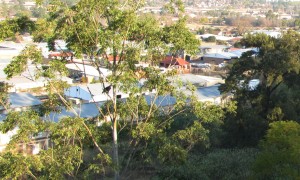
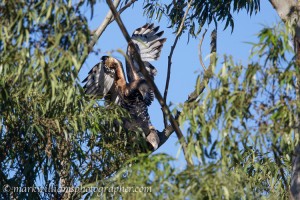
What is the preferred nesting tree?
Locally, the exotic Blue Gum Eucalyptus saligna is the most frequently used nesting tree. A greater variety of indigenous trees are used. I cannot say which species are selected as this requires quantifying the proportions of available suitable trees available – hindered by a swathe of analytical assumptions. The Blue Gum has traits which may be preferred; they grow rapidly to tall heights, the open radial branching pattern provides many good locations for a solid nest platform, and the powdery smooth bark is pretty difficult for monkeys to climb. Monkeys and baboons harassing eagles at the nest site is probably their most important natural threat. The use of Blue Gums by Crowned Eagles, Black Sparrowhawks, Harrier-hawks and Fish-eagles (all observed in my study area), complicates the issues regarding the management of exotic tress. The government organisation Working for Water and other local action groups clear a lot of invasive vegetation, and it irks me when a nest tree of a protected raptor is felled or ring-barked.
How big are the Crowned Eagle territories?
Five territorial adults have been fitted with backpack mounted GPS devices to specifically look at home range and preferred hunting habitats. The data collection is still ongoing for three of these birds so there is plenty of scope to extend the research. So far it appears that the home range primarily depends on the available area of indigenous forest. One of the female eagles used small fragmented forests across a range of 35 km2 of sugarcane land. Another female within the city has thus far used 5.8 km2 of mostly D’MOSS urban forest reserve. The home range of pairs in Tai National Park, Ivory Coast were 6.5 km2 (Shultz 2002) so it is surprising to suspect that similar small home range sizes can be maintained in this highly modified urban landscape. Perhaps contrary to common belief, the food resources in the urban environment are high and appear to suit the eagles quite well.
What is the preferred wild prey, and do the Crowned Eagles take pets like dogs or house cats??
The very essence of this research was to address this human-wildlife conflict. In recent years we have followed popular media and a general perception among the public of Durban that Crowned Eagles are targeting pets. Indeed there are almost annual cases of cats and small dog breeds being attacked, which often get sensationalized in the newspapers. So it was crucial to provide a balanced view on this topic. We have had a huge success in the use of nest cameras, possibly the first extensive study of this type for Crowned Eagles. In the last two years, cameras at 11 nests covering 1,600 days of monitoring provided a dataset of over 800 prey animals, 85% were identified to species.
What has been surprising is that the vast majority of prey (93%) is urban wildlife. Generally urban ecosystems provide abundant opportunities for a very small range of urban exploiting animals – think pigeons – but indigenous biodiversity is usually negatively affected. The D’MOSS system has protected a wide range of grasslands and forests and the diversity in Durban is possibly an exceptional global example for integrating wildlife into an urban ecosystem. Some of the favourite Crowned Eagle prey have adapted to urban resources; Rock Hyrax, Hadeda Ibis, Vervet Monkeys, Blue Duiker, and a variety of small carnivores (mongooses, genets).
Cats comprise 0.7% of the prey from these urban nests, they were not separated into domestic or feral individuals. No dogs at all were observed from camera studies. From this data it is clear that pets are not at great risk by adult eagles during the breeding season, however it is during the period where the juvenile eagle is preparing for independence that pet encounters become more frequent. This provides an avenue for effective education and management options.
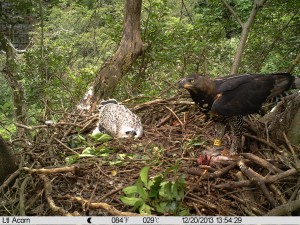
How do Crowned Eagles hunt? Do males and females select different prey?
The Crowned Eagle has muscular legs, thick tarsi, short toes and huge talons. The pressure delivered to the talon tip is immense – and necessary when considering its prey options. The ability for Crowned Eagles to quickly incapacitate large prey is an adaptation shared by other ‘monkey-eating’ eagles. I have been told accounts by several people who have seen an amazing and probably widespread strategy for Crowned Eagles. This typically starts with the female soaring boldly over the canopy which incites the troop of monkeys to rush to the top of the trees, watch closely and bark at this threat… Suddenly the male eagle bursts upwards from below the troop, plucking a monkey on his way through. He, smaller and more agile, has taken a route below the canopy at high speed, arriving on the scene completely undetected. He needs to grip the monkey on the head to incapacitate it – a poorly aimed strike could result in a life-threatening tumble through the canopy, and the whole troop rushing to protect the struggling victim. I suppose you must be extremely lucky to see such a thing! Typically though the Crowned Eagle is an ambush predator and will sit in a hidden vantage point over some well used game trail or rockery, ready to swoop down onto a duiker or hyrax that moves into a vulnerable position. Typical prey are less than 5 kg in size, fitting neatly into a crowned eagles clutches; hyrax, young duiker, mongooses etc. Larger prey cannot be carried whole and the Crowned Eagle expertly guts then dismembers large prey – taking portions to the nest in successive trips.
It seems that the success rates between independent versus cooperative hunting strategies merits a lot more research, and I’d be very interested to know whether the adult pair goes out hunting together once the chick is getting older and ready to fledge. Trouble is – the thick forest is an extremely difficult place to observe the eagle and its prey, without being noticed.
How long to the young stay in the nest and after fledging, how long are they dependent on their parents?
The common held belief, which is confirmed from the tropical regions, is that the crowned eagle breeds biennially – one chick every two years. The juvenile eagle has a lot to learn about hunting large prey and intelligent species such as monkeys. Again a surprising difference with the urban eagles is numerous cases of annual breeding. We are finding that in a few cases the adults forcibly evict the juvenile from the nest area in order to breed every year. The breeding productivity and post-fledging dependency period are topics I hope to address while extending this research.
What is known about the dispersal of young Crowned Eagles?
This is an excellent question and as far as I am aware, very little is known about juvenile and sub-adult movements. Such an important aspect of the biology and data for population demographics remains unanswered. We have a few indications from ringed eagles which have been recovered dead, but I hope that all of the ringing taking place will set up an excellent population study for a student in the year 2020! Crowned eagles take 4 to 6 years to reach breeding age, and over the last two seasons I have ringed 39 Crowned Eagles. The use of solar-CCT or other such long-life telemetry would be of great value for the project however this is particularly limited by the expense of the units and funding availability.
Did you find any interaction or competition with other raptors?
Yes other raptors, particularly Black Sparrowhawks and Fish Eagles (both also successful urban adapters in Durban) have been known to use Crowned Eagle nests, and vice versa. Most surprising is the nuisance that Egyptian Geese proved to be. It is quite well known now that ‘Gyppo’s’ are able to usurp Black Sparrowhawk nest – but it was surprising to see them holding ground against Crowned Eagles! Just days after the juvenile at Zimbali fledged, the geese moved in! The geese held their ground, and while the adult eagles continued to deliver food to the nest, the geese immediately dumped that meat to the ground and the young eagle had to settle with sweeping it off the floor. 40 days later the 7 ducklings hatched and soon jumped to the ground and moved off to the nearest pond.
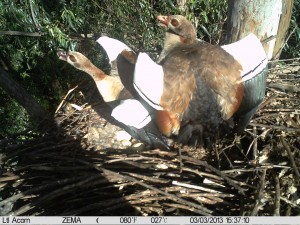
What are the main natural mortality causes for Crowned Eagles in the study area?
Unfortunately I haven’t discovered any mortalities that have been of natural causes. The mortality so far includes electrocutions and gunshot. One adult male while apparently chasing monkeys in the suburbs, flew into the wall of a house at 4am and broke his neck! Others eagles have been rehabilitated after poisoning, and collisions with vehicles. All of these mortalities are effected by human causes in some way.
How is the population doing in your study area?
This requires more work. Hopefully with all the ringing and future resightings we might learn something about the population structure. A couple of cases lead me to suggest that the population is limited by available nest sites in this urban landscape and that there are non-breeding drifters in the population. In particular, the above case of the adult male colliding with a wall at 4 am last March – by June the female there has already attracted a new male. They promptly started building a new nest and I observed them mating last week.
What do you see as the main threats for Crowned Eagles in your study area and the rest of South Africa?
I suspect that the urban landscape is quite stable at this stage. The DMOSS areas are protected from further housing development as they provide many important ecosystem services. It is important to provide balanced data when the public and press get hold of dramatic pet-attack stories. The continued availability of urban wildlife like hyrax, ibis, duiker and monkeys are also important locally. Further afield in South Africa there are plenty of well management forests, reserves, and game farms where crowned eagle populations appear quite secure. In contrast, from what I have read and heard from Africa north of the Capricorn line, the majority of the Crowned Eagles range is under severe threat on a large scale.
Where should future research look at in South Africa and across the whole continent?
Crowned Eagle studies are well represented in South Africa, a peripheral part of their range. I worry most for the huge areas of congo basin, west African and east African parts of the Crowned Eagle range being decimated by mining, deforestation, bushmeat industry, and direct persecution and conflict. The Crowned Eagle is one amongst many iconic species that can ‘speak for the trees’.
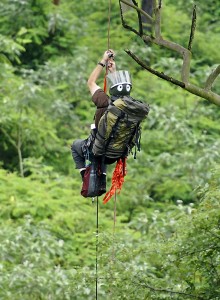
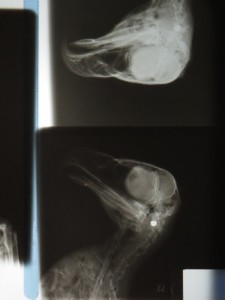
How do you study the birds?
Often it seems like I spend much more time sitting in Durban traffic than watching the birds! There are just so many nest sites to get around and survey every fortnight, and access to most nests requires very little trekking. For example I can check three nests while driving the highway towards the city centre, and a number of other nests from certain parking spots without opening the car door. On a long summers day I could survey 9 nests. At other nests I have the opportunity to explore the depths of the urban reserves on foot and thoroughly enjoy the diversity and richness that can be found within the city.
The other major part of my study activities was the successful use of camera traps to record breeding behaviours and prey. 11 nests were monitored with cameras using time lapse photography. By the end of the study I had collected over 800,000 images and recorded 1,200 days of dawn-to-dusk time-lapse recordings! These cameras were all placed within about 3 meters of the nest and I have used fixed-rope climbing to get to the nests (between 10 and 35 meters up). Fortunately because of the rope in the way, and the eyes in the back of my helmet, I did not get hit by any of the female eagles, despite their reputation to defend their nest vigorously.
What was your most amazing experience with Crowned Eagles?
I am finding it very difficult to identify one particular moment. The most wanted experience is to observe a successful hunt. Currently though I am thrilled with the project as a whole and especially enjoy being close to the birds in three ways:
1. At several urbanised sites the eagles have become very accustomed to normal activity around their nest. For instance dozens of people stand at the balcony of the Fairmont lodge restaurant at Zimbali Coastal Resort. There you can observe the eagles, their nest and any chick tending activities at eye-level just 30 meters away.
2. Although invasive, climbing the nest trees to service cameras and ring nestlings has also provided a different experience of closeness. Crowned Eagles are notoriously known for their nest defence strategies and I have had the adrenaline pumping pleasure of looking face to face with a monstrous female eagle as she fixes her gaze and approaches on a steep glide towards me. In the very last instance I duck my head and expose the painted ‘eyes’ on the top of my riot helmet and feel the rush of air push down on me as she pulls up and over.
3. As scientist we are supposed to observe objectively. However I cannot help but get attached to many of these young eagles reared in my study area. Some more than others, especially if they have been under the extreme scrutiny of a nest camera study. Almost all juveniles have been colour-ringed as nestlings or fledglings and they are seen for months around their nest site, post-fledging. It is amazing for me to feel so thrilled every time I resight one of the ID tagged eagles. Equally passionately felt are the losses, and there have been tears over eagles recovered shot or electrocuted.
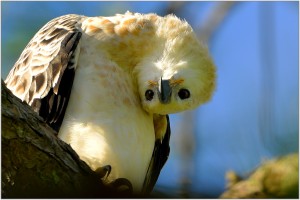
Shane, Many thanks for answering our questions.
Interview by Markus Jais.


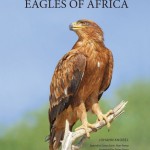
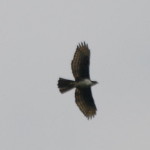

Great question and answer regarding this incredible bird. Very encouraging to see there ability to adapt to urban settings. I had a Merlin nest in a dead tree 2 doors down from my in a suburban location with 1/4 acre lots. Amazing to me when we found the nest as I did not expect them to be so close. The perigrine nesting on skyscraper window ledges in Chicago we never thought we would ever see 30 years ago when we were breeding birds for release sites.
Wonderful artical I enjoyed greatly. Thanks for posting it.